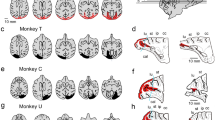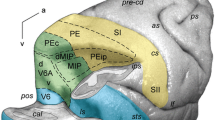Summary
Eight monkeys (Macaca mulatta) were trained on a spatial localization task before and after either total ablation of the striate cortices with partial damage to circumstriate cortices, complete colliculus removals, or combined ablations. The lesions were histologically verified. The task, given under normal room illumination, required the animals to reach for a target randomly placed in one of eight equal segments of a white disk located at arm's length. An apple cube, affixed to the center of the target, served as the reward for accurate reaching. A correct response consisted of an initial contact with either the target or the apple cube directly. The animal was trained sequentially to a criterion level of performance set at 90% correct responses over four 56-trial consecutive sessions using black disks of decreasing diameter (i.e., 90 mm, 55 mm, 35 mm, and 15 mm). Finally, only the apple cube, about 10 mm on a side, was presented.
Four animals with complete or almost complete bilateral superior colliculus removals were unimpaired in their performances. The other four subjects with total striate cortex removals could be trained to reach accurately for all targets, but with marked deficits on the first and last tests, i.e., the 90 mm disk and the apple cube. When the striate cortex was ablated in the colliculectomized animals, they failed to attain a criterion level of performance in almost 6,000 trials.
These results indicate that the superior colliculus is at least one structure that is critical for spatial localization in the absence of striate cortex, but it is not crucial for this capacity in the otherwise intact animal. In addition, the findings confirmed previous studies which showed that monkeys with total bilateral striatectomies could reacquire the ability to execute accurate visually guided reaches. The present and earlier studies emphasize the primary importance of the geniculostriate system for the function explored and do not support a sharp dichotomy between two independent visual systems in the monkey.
Similar content being viewed by others
References
Anderson KV, Symmes D (1969) The superior colliculus and higher visual functions in the monkey. Brain Res 13: 37–52
Benevento LA, Fallon JH (1975) The ascending projections of the superior colliculus in the rhesus monkey (Macaca mulatta). J Comp Neurol 160: 339–362
Bonin G v, Bailey P (1947) The neocortex of Macaca mulatta. University of Illinois Press, Urbana, Ill.
Butter CM (1974) Effects of superior colliculus, striate, and prestriate lesions on visual sampling in rhesus monkey. J Comp Physiol Psychol 87: 905–917
Butter CM, Weinstein C, Bender DB, Gross CG (1978) Localization and detection of visual stimuli following superior colliculus lesions in rhesus monkeys. Brain Res 156: 33–49
Cynader M, Berman N (1972) Receptive-field organization of monkey superior colliculus. J Neurophysiol 35: 187–201
Edwards AL (1960) Experimental design in psychological research. Holt, Rinehart and Winston, New York
Feinberg T, Pasik P, Pasik T (1977) Visually mediated space localization in monkeys without striate cortex. Fed Proc 36: 507
Feinberg T, Pasik T, Pasik P (1978) Extrageniculostriate vision in the monkey. VI. Visually guided accurate reaching behavior. Brain Res 152: 422–428
Harting JK, Casagrande VA, Weber JT (1978) The projection of the primate superior colliculus upon the dorsal lateral geniculate nucleus. Autoradiographic demonstration of interlaminar distribution of tecto-geniculate axons. Brain Res 150: 593–599
Hubel DH, LeVay S, Wiesel TN (1975) Mode of termination of retinotectal fibers in macaque monkeys: An audioradiographic study. Brain Res 96: 25–40
Humphrey NK (1974) Vision in a monkey without striate cortex. A case study. Perception 3: 241–255
Humphrey NK, Weiskrantz L (1967) Vision in monkeys after removal of the striate cortex. Nature 215: 595–597
Keating EG (1975) Effects of prestriate and striate lesions on the monkey's ability to locate and discriminate visual forms. Exp Neurol 47: 16–25
Keating EG (1980) Residual spatial vision in the monkey after removal of striate and preoccipital cortex. Brain Res 187: 271–290
Keating EG, Dineen J (in press) Visual-motor transforms of the primate tectum. In: Ingle DJ, Goodale M, Mansfield RJW (eds) Advances in the analysis of visual behavior. M.I.T. Press Cambridge, Mass.
Kurtz D, Leiby C, Butter CM (1980) Reaching to the periphery abolishes deficits in peripheral vision of monkeys with superior colliculus lesions. Neurosci Abstr 6: 481
Latto R (1978) The effects of bilateral frontal eye-field, posterior parietal or superior collicular lesions on visual search in the rhesus monkey. Brain Res 146: 35–50
Leporé F, Ptito M, Cardu B, Dumont M (1976) Effects of striatectomy and colliculectomy on achromatic thresholds in the monkey. Physiol Behav 16: 285–291
Lund JS, Lund RD, Hendrickson AE, Bunt AH, Fuchs AF (1975) The origin of efferent pathways from the primary visual cortex, area 17, of the macaque monkey as shown by retrograde transport of horseradish peroxidase. J Comp Neurol 164: 287–304
Mackinnon DA, Gross CG, Bender DB (1976) A visual deficit after superior colliculus lesions in monkeys. Acta Neurobiol Exp (Warsz) 36: 169–180
Mehler WR, Feferman ME, Nauta WJH (1960) Ascending axon degeneration following anterolateral cordotomy. An experimental study in the monkey. Brain 83: 718–750
Miller M, Pasik P, Pasik T (1980) Extrageniculostriate vision in the monkey. VII. Contrast sensitivity functions. J Neurophysiol 43: 1510–1526
Mohler CW, Wurtz RH (1977) Role of striate cortex and superior colliculus in visual guidance of saccadic eye movements in monkey. J Neurophysiol 40: 75–94
Moll L, Kuypers HGJM (1977) Premotor cortical ablations in monkeys. Contralateral changes in visually guided reaching behavior. Science 198: 317–319
Mort E, Cairns S, Hersch H, Finlay B (1980) The role of the superior colliculus in visually guided locomotor and visual orienting in the hamster. Physiol Psychol 8: 20–28
Pasik T, Pasik P (1971) The visual world of monkeys deprived of striate cortex: effective stimulus parameters and the importance of the accessory optic system. In: Shipley T, Dowling JE (eds) Visual processes in vertebrates. Vision Res [Suppl] 3: 419–435
Pasik P, Pasik T (1973a) Extrageniculostriate vision in the monkey. V. Role of the accessory optic system. J Neurophysiol 36: 450–457
Pasik T, Pasik P (1973b) Extrageniculostriate vision in the monkey. IV. Critical structures for light vs no-light discrimination. Brain Res 56: 165–182
Pasik T, Pasik P (1980) Extrageniculostriate vision in primates. In: Lessell S, van Dalen JTW (eds) Neuro-ophthalmology. Excerpta Medica, Amsterdam, pp 95–119
Pasik P, Pasik T, Bender MB (1961) Light discrimination after additional brain damage in monkeys with bilateral striatectomy. Fed Proc 20: 328
Pasik P, Pasik T, Bender MB (1969a) The pretectal syndrome in monkeys. I. Disturbances of gaze and body posture. Brain 92: 521–534
Pasik P, Pasik T, Schilder P (1969b) Extrageniculostriate vision in the monkey: Discrimination of flux-equated figures. Exp Neurol 24: 421–437
Pasik P, Pasik T, Hámori J, Szentǵothai J (1973a) Golgi type II interneurons in the neuronal circuit of the monkey lateral geniculate nucleus. Exp Brain Res 17: 18–34
Pasik T, Pasik P, Schilder P, Wininger J (1973b) Extrageniculostriate vision in the monkey. Effect of circumstriate cortex or superior colliculi ablations. Excerpta Medica, Amsterdam Int Congr Series No 296, pp 201–202
Pollack JG, Hickey TL (1979) The distribution of retinocollicular axon terminals in rhesus monkey. J Comp Neurol 185: 587–602
Rosvold HE, Mishkin M, Szwarcbart MK (1958) Effects of subcortical lesions in monkeys on visual-discrimination and single-alternation performance. J Comp Physiol Psychol 51: 437–444
Schilder P, Pasik T, Pasik P (1971) Extrageniculostriate vision in the monkey. II. Demonstration of brightness discrimination. Brain Res 32: 383–398
Schilder P, Pasik P, Pasik T (1972) Extrageniculostriate vision in monkey. III. Circle vs triangle and “red vs green” discrimination. Exp Brain Res 14: 436–448
Schiller PH, Stryker M, Cynader M, Berman N (1974) Response characteristics of single cells in the monkey superior colliculus following ablation or cooling of visual cortex. J Neurophysiol 37: 181–194
Schiller PH, True SD, Conway JL (1979) Effects of frontal eye field and superior colliculus ablations on eye movements. Science 206: 590–592
Schneider GE (1967) Contrasting visuomotor functions of tectum and cortex in the golden hamster. Psychol Forsch 32: 52–62
Solomon SJ (1980) The effects of superior colliculus and/or striate cortex ablations on a visual spatial localization task. Doctoral dissertation, City University of New York
Solomon SJ, Pasik P, Pasik T (1979) The effects of striate cortex and/or superior colliculus ablations on accurate reaching by monkeys. Neurosci Abstr 5: 808
Teuber H-L (1955) Physiological psychology. Ann Rev Psychol 6: 267–296
Thompson R, Meyers RE (1971) Brainstem mechanisms underlying visually guided responses in the rhesus monkey. J Comp Physiol Psychol 74 (3): 479–512
Trevarthen CB (1968) Two mechanisms of vision in primates. Psychol Forsch 31: 299–337
Tuttle L, Satterly J (1925) Theory of measurements. Longmans, London
Weiskrantz L, Cowey A, Passingham C (1977) Spatial responses to brief stimuli by monkeys with striate cortex ablations. Brain 100: 655–670
Wilson ME, Toyne MJ (1970) Retino-tectal and cortico-tectal projections in Macaca mulatta. Brain Res 24: 395–406
Author information
Authors and Affiliations
Additional information
Aided by NIMH Research Grant No. MH-02261
Rights and permissions
About this article
Cite this article
Solomon, S.J., Pasik, T. & Pasik, P. Extrageniculostriate vision in the monkey. Exp Brain Res 44, 259–270 (1981). https://doi.org/10.1007/BF00236563
Received:
Issue Date:
DOI: https://doi.org/10.1007/BF00236563




